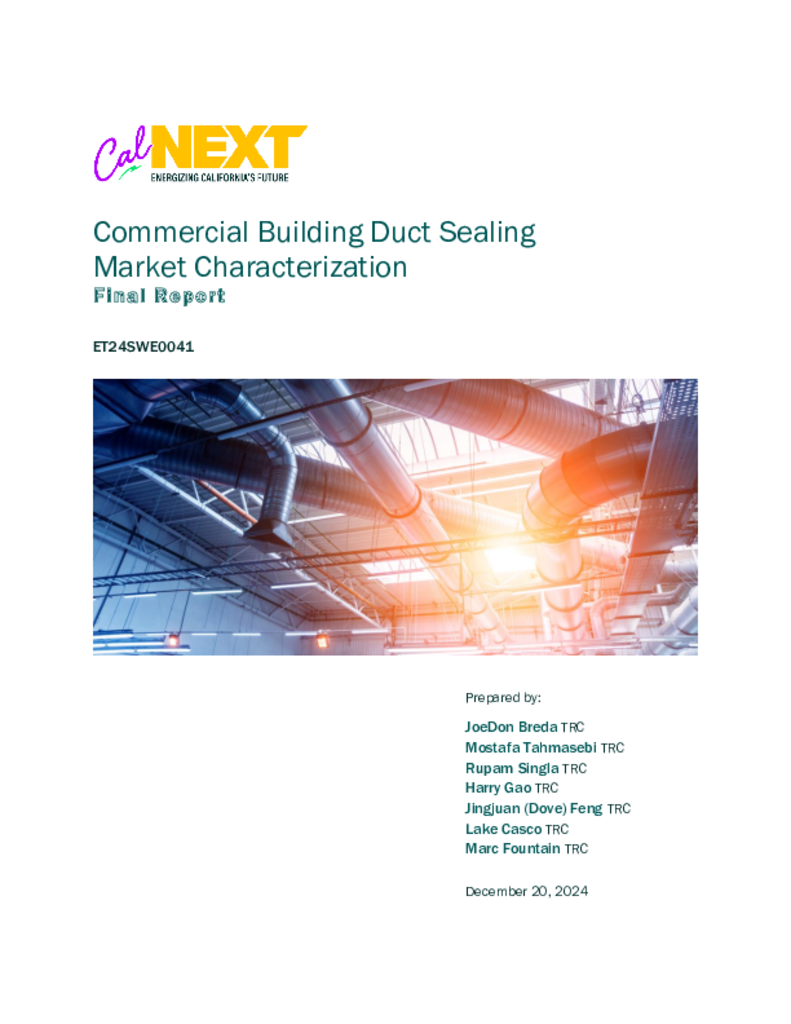ET24SWE0041 - Commercial Building Duct Sealing Market Characterization
In commercial buildings where forced-air heating and cooling systems are employed, the efficiency of ductwork plays a pivotal role in both energy management and indoor air quality. According to the U.S. Energy Information Administration's (EIA), ventilation systems in commercial buildings consume around 1.54 quadrillion British thermal units of energy consumption nationally, or roughly 29 percent of total HVAC energy use in commercial buildings. Another study concluded that air-leakage rates in duct systems can range from 0% to 30%, with most measurements falling between 10% and 20%. Depending on the existing heating, cooling and ventilation (HVAC) baseline system types and conditions, prior field studies and energy simulations have shown duct sealing can save 12-34 percent fan energy use, leading to 2 percent electricity saving per building.
This study is a market research study evaluating duct sealing technologies in commercial buildings with particular focus on single zone constant volume HVAC systems for buildings with less than 5,000 square feet of conditioned floor area. The study lays the groundwork for a possible subsequent energy savings and cost analysis study as a follow-on project with in-depth quantitative analysis. Taken together, this project and the energy savings and cost analysis project will support development of a commercial duct sealing measure package separately funded by a CA IOU (SDG&E)
The market characterization involves evaluating the availability of technologies, establishing market baselines, potential for adoption, and understanding implementation needs in existing commercial buildings. The project team will analyze and compare a range of duct sealing solutions, from traditional methods like manual taping and mastic application to advanced technologies such as non-toxic aerosol sprays. This comparison will emphasize the advantages, disadvantages, and effectiveness of each method, with a particular focus on identifying cost-effective and impactful options. This study will also research different duct leakage tests applicable for commercial buildings, including the leakage to outside test and the total leakage test. The project team will conduct literature review as well as interviews with industry experts, HVAC professionals, and policymakers to understand practical implementation, market trends, and barriers to adoption. The findings from this market research will inform and support development of a commercial building duct sealing measure package or measure package update.
The California investor-owned utility San Diego Gas & Electric commissioned a study to evaluate duct sealing technologies in commercial buildings, comparing traditional methods like manual taping and mastic application to advanced aerosol sealants. The research, based on literature reviews and expert interviews, revealed that HVAC airflow leakage—often 10 to 20 percent and up to 35 percent in older systems—wastes fan, cooling, and heating energy, leading to higher costs and reduced performance. Effective sealing can cut leakage to 5 percent or less, with manual methods best for large leaks and aerosol sealants optimal for smaller gaps. Large markets like healthcare, hotels, and schools actively adopt duct sealing retrofits, though other opportunities exist, especially for older systems or those never tested for leakage. Key barriers include implementation costs and limited industry awareness. Incentivizing duct testing and sealing could yield annual HVAC energy savings of 15 to 30 percent, addressing a persistent efficiency challenge that occurs year-round.

